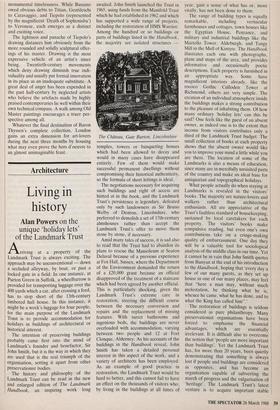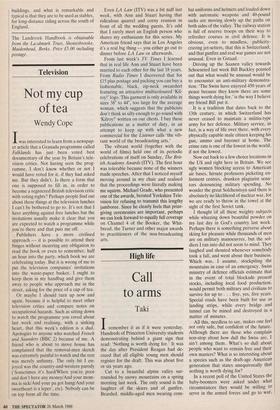Architecture
Living in history
Alan Powers on the unique 'holiday lets' of the Landmark Trust
Arriving at a property of the Landmark Trust is always exciting. The approach may be unconventional — down a secluded alleyway, by boat, or past a locked gate in a field. In one instance, at Purton Green in Suffolk, a wheelbarrow is provided for transporting luggage over the 400 yards which a car, after crossing a ford, has to stop short of the 13th-century timbered hall house. In this instance, it might be a week's luggage for four people, for the main purpose of the Landmark Trust is to provide accommodation for holidays in buildings of architectural or historical interest.
The intention of preserving buildings probably came first into the mind of Landmark's founder and benefactor, Sir John Smith, but it is the way in which they are used that is the real triumph of the organisation, setting it apart from other preservationist bodies.
The history and philosophy of the Landmark Trust can be read in the new and enlarged edition of The Landmark Handbook, an inspiring work long awaited. John Smith launched the Trust in 1965, using funds from the Manifold Trust which he had established in 1962 and which has supported a wide range of projects, including the restoration of HMS Warrior. Among the hundred or so buildings or parts of buildings listed in the Handbook, the majority are isolated structures — The Château, Gate Burton, Lincolnshire temples, towers or banqueting houses which had been allowed to decay and would in many cases have disappeared entirely. Few of them would make successful permanent dwellings without compromising their historical authenticity, so the formula of short lettings is ideal.
The negotiations necessary for acquiring such buildings and right of access are hinted at in the book, and the Landmark Trust's persistence is legendary, defeated only by such landowners as Sir Bruno Welby of Denton, Lincolnshire, who preferred to demolish a set of 17th-century almshouses rather than accept the Landmark Trust's offer to move them stone by stone, if necessary.
Amid many tales of success, it is sad also to read that the Trust had to abandon its plans to rescue the Mausoleum at Seaton Delaval because of a previous experience at Fox Hall, Sussex, where the Department of the Environment demanded the return of a £20,000 grant because an official disapproved of the treatment of a staircase which had been agreed by another official. This is particularly shocking, given the Landmark Trust's extreme care in restoration, steering the difficult course between the necessary conversion and repairs and the replacement of missing features. With turret bathrooms and ingenious beds, the buildings are never overloaded with accommodation, varying between two people and 12 at Fort Clonque, Alderney. As his accounts of the buildings in the Handbook reveal, John Smith has taken a detailed personal interest in this aspect of the work, and a variety of architects has been employed. As an example of good practice in restoration, the Landmark Trust would be hard to better, and this cannot fail to have an effect on the thousands of visitors who, by living in the buildings at all times of
year, gain a sense of what has or, more vitally, has not been done to them.
The range of building types is equally
remarkable, including vernacular farmhouses and cottages, town houses like the Egyptian House, Penzance, and military and industrial buildings like the Martello Tower, Aldeburgh, and Tangy Mill in the Mull of Kintyre. The Handbook illustrates each one with photographs, plans and maps of the area, and provides informative and occasionally poetic descriptions. Each property is furnished in an appropriate way. Some have magnificent interiors already, like the rococo Gothic Culloden Tower at Richmond, others are very simple. The creation of an individual atmosphere inside the buildings makes a strong contribution to the pleasure of inhabiting them. Of how many ordinary 'holiday lets' can this be said? One feels like the guest of an absent owner, as indeed one is to the extent that income from visitors contributes only a third of the Landmark Trust budget. The small collection of books at each property shows that the absent owner would like you to improve your mind a little while you are there. The location of some of the Landmarks is also a means of education, since many are in mercifully unvisited parts of the country and make an ideal base for antiquarian and topographical holidays.
What people actually do when staying at Landmarks is revealed in the visitors' books. The majority are nature-lovers and walkers rather than architectural enthusiasts. All are appreciative of the Trust's faultless standard of housekeeping, sustained by local caretakers for each property. The visitors' books make compulsive reading, but even one's own contributions take on a cringe-making quality of embarrassment. One day they will be a valuable tool for sociological analysis of the middle class in our time. Yet it cannot be in vain that John Smith quotes from Bunyan at the end of his introduction
to the Handbook, hoping that 'every day a few of our many guests, as they set up
house in one of our many places, may feel that "here a man may, without much molestation, be thinking what he is, whence he came, what he has done, and to what the King has called him".'
The restoration of buildings is seldom considered as pure philanthropy. Many preservationist organisations have been forced to emphasise the financial advantages, which are essentially irrelevant. It is difficult also to overcome the notion that 'people are more important than buildings'. Yet the Landmark Trust has,.for more than 20 years, been quietly demonstrating that something is always lost if people and buildings are considered as opposites, and has become an organisation capable of subverting the march of progress and the vulgarisation of `heritage'. The Landmark Trust's latest venture is to acquire important stable buildings, and what is remarkable and typical is that they are to be used as stables, for long-distance riding across the south of England.



















































 Previous page
Previous page